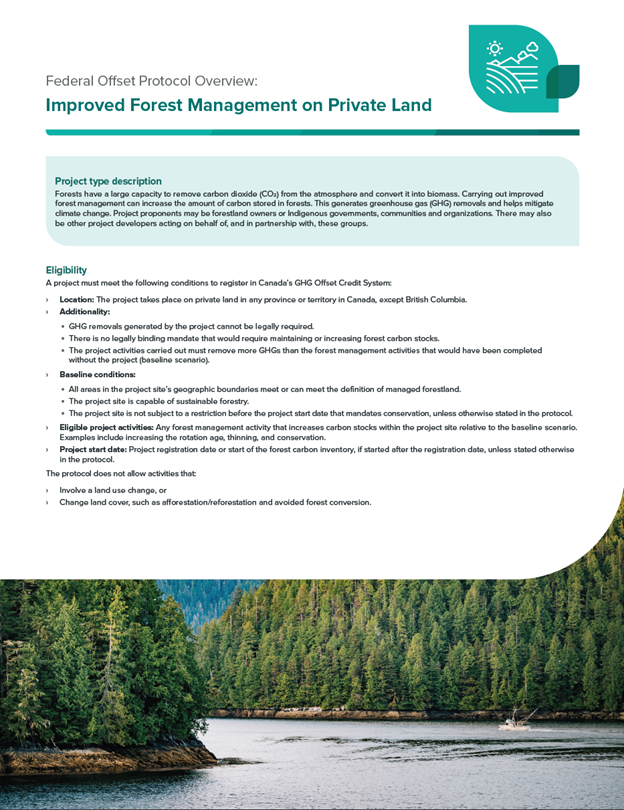Federal offset protocol overview: Improved forest management on private land

Download the alternative format
(PDF format, 1222 KB, 2 pages)
Project type description
Forests have a large capacity to remove dioxide (CO2) from the atmosphere and convert it into biomass. Carrying out improved forest management can increase the amount of carbon stored in forests. This generates greenhouse gas (GHG) removals and helps mitigate climate change.
Project proponents may be forestland owners or Indigenous governments, communities and organizations. There may also be other project developers acting on behalf of, and in partnership with, these groups.
Eligibility
A project must meet the following conditions to register in Canada’s GHG Offset Credit System:
- Location: The project takes place on private land in any province or territory in Canada, except British Columbia
- Additionality
- GHG removals generated by the project cannot be legally required
- There is no legally binding mandate that would require maintaining or increasing forest carbon stocks.
- The project activities carried out must remove more GHGs than the forest management activities that would have been completed without the project (baseline scenario)
- Baseline conditions
- All areas in the project site’s geographic boundaries meet or can meet the definition of managed forestland
- The project site is capable of sustainable forestry
- The project site is not subject to a restriction before the project start date that mandates conservation, unless otherwise stated in the protocol
- Eligible project activities: Any forest management activity that increases carbon stocks within the project site relative to the baseline scenario. Examples include increasing the rotation age, thinning, and conservation.
- Project start date: Project registration date or start of the forest carbon inventory, if started after the registration date, unless stated otherwise in the protocol
The protocol does not allow activities that:
- involve a land use change, or
- change land cover, such as afforestation/reforestation and avoided forest conversion
Quantification
GHG removals are based on the difference between carbon stocks over time in the project scenario and in the baseline scenario. This includes factoring in carbon storage associated with harvested wood products. The proponent must also consider GHG emissions from the burning of biomass, and activity-shifting and market leakage.
Modelling and measurement
Baseline scenario carbon stocks are always modelled. Project scenario carbon stocks are directly measured through a forest carbon inventory. There is an option to model changes in carbon stocks between inventory updates.
Reporting and verification
The proponent must prepare a project report for each reporting period. The first reporting period is one year, and subsequent reporting periods can be up to 6 years. Project reports must be verified by an accredited verification body.
Permanence and reversals
A reversal is a decrease in the difference between project and baseline scenario carbon stocks, for example due to natural disturbance. To ensure permanence of GHG removals:
- the proponent must prepare a reversal risk management plan. The plan must identify reversal risk mitigation measures that will be implemented.
- the proponent must monitor the GHG removals for 100 years after the crediting period ends.
- a portion of offset credits are deposited into the environmental integrity account (EIA). This is to account for forestry-specific reversal risks. The maximum amount that can be deposited is 27%. This amount can be decreased if certain reversal risk mitigation measures are implemented. For example, measures that involve Indigenous communities in permanence monitoring or reversal risk management planning.
Other key requirements
- GHG removals must be unique. The same removals cannot earn credits under another offset system, program or other GHG reduction mechanism. The proponent must have exclusive entitlement to claim the offset credits.
- Projects can be aggregated, but they must be located in the same province or territory
- A project can generate credits for 25 years. There is a potential to renew the crediting period to a maximum crediting period length of 100 years.
- The proponent must meet requirements for environmental safeguarding. A project cannot result in negative environmental impacts compared to the baseline scenario.
Disclaimer: The information in this document is intended for communication purposes only and reflects version 1.0 of the protocol published in May 2024. It does not replace the requirements set out in the Improved Forest Management on Private Land federal offset protocol or the Canadian Greenhouse Gas Offset Credit System Regulations. Please refer to these documents for a complete list of rules and requirements. In the event of any conflict or difference between this protocol overview and any legal requirements, the latter prevail.